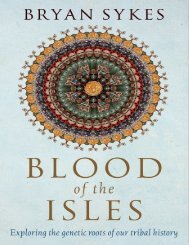Create successful ePaper yourself
Turn your PDF publications into a flip-book with our unique Google optimized e-Paper software.
IN A LETTER of my father’s written on the 16th of July 1964 he said:<br />
The germ of my attempt to write legends of my own to fit my private languages was the<br />
tragic tale of the hapless Kullervo in the Finnish Kalevala. It remains a major matter in the<br />
legends of the First Age (which I hope to publish as The Silmarillion), though as ‘The<br />
Children of Húrin’ it is entirely changed except in the tragic ending. The second point was<br />
the writing, ‘out of my head’, of ‘The Fall of Gondolin’, the story of Idril and Earendel,<br />
during sick-leave from the army in 1917; and by the original version of the ‘Tale of Lúthien<br />
Tinúviel and Beren’ later in the same year. That was founded on a small wood with a great<br />
undergrowth of ‘hemlock’ (no doubt many other related plants were also there) near Roos in<br />
Holderness, where I was for a while on the Humber Garrison.<br />
My father and mother were married in March 1916, when he was twenty-four and she was twentyseven.<br />
They lived at first in the village of Great Haywood in Staffordshire; but he embarked for<br />
France and the Battle of the Somme early in June of that year. Taken ill, he was sent back to England<br />
at the beginning of November 1916; and in the spring of 1917 he was posted to Yorkshire.<br />
This primary version of The Tale of Tinúviel, as he called it, written in 1917, does not exist—or<br />
more precisely, exists only in the ghostly form of a manuscript in pencil that he all but entirely erased<br />
for most of its length; over this he wrote the text that is for us the earliest version. The Tale of<br />
Tinúviel was one of the constituent stories of my father’s major early work of his ‘mythology’, The<br />
Book of Lost Tales, an exceedingly complex work which I edited in the first two volumes of The<br />
History of Middle-earth, 1983–4. But since the present book is expressly devoted to the evolution of<br />
the legend of Beren and Lúthien I will here very largely pass by the strange setting and audience of<br />
the Lost Tales, for The Tale of Tinúviel is in itself almost entirely independent of that setting.<br />
Central to The Book of Lost Tales was the story of an English mariner of the ‘Anglo-Saxon’ period<br />
named Eriol or Ælfwine who, sailing far westwards over the ocean, came at last to Tol Eressëa, the<br />
Lonely Isle, where dwelt Elves who had departed from ‘the Great Lands’, afterwards ‘Middle-Earth’<br />
(a term not used in the Lost Tales). During his sojourn in Tol Eressëa he learned from them the true<br />
and ancient history of the Creation, of the Gods, of the Elves, and of England. This history is ‘The<br />
Lost Tales of Elfinesse’.<br />
The work is extant in a number of battered little ‘exercise books’ in ink and pencil, often<br />
formidably difficult to read, though after many hours of peering at the manuscript with a lens I was<br />
able, many years ago, to elucidate all the texts with only occasional unsolved words. The Tale of<br />
Tinúviel is one of the stories that was told to Eriol by the Elves in the Lonely Isle, in this case by a<br />
maiden named Vëannë: there were many children present at these story-tellings. Sharply observant of<br />
detail (a striking feature), it is told in an extremely individual style, with some archaisms of word and<br />
construction, altogether unlike my father’s later styles, intense, poetic, at times deeply ‘elvishmysterious’.<br />
There is also an undercurrent of sardonic humour in the expression here and there (in the<br />
terrible confrontation with the demonic wolf Karkaras as she fled with Beren from Melko’s hall<br />
Tinúviel enquires ‘Wherefore this surliness, Karkaras?’).<br />
Rather than awaiting the conclusion of the Tale I think it may be helpful to draw attention here to<br />
certain aspects of this earliest version of the legend, and to give brief explanations of some names<br />
important in the narrative (which are also to be found in the List of Names at the end of the book).
















